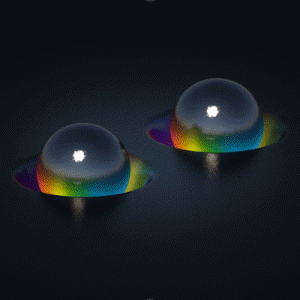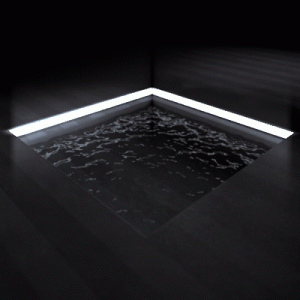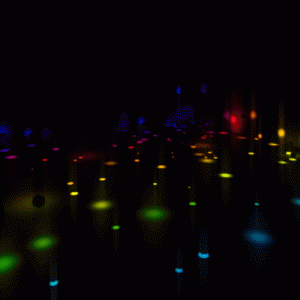creyes1 Project-02 Variable Faces
//Christopher Reyes
//Section D
//creyes1@andrew.cmu.edu
//Project-02 Variable Faces
var backgroundR = 255;
var backgroundG = 250;
var backgroundB = 221;
var modelNo = "24601";
var antennaHeight = 50;
var antennaWidth = 10;
var antennaColorR = 204;
var antennaColorG = 86;
var antennaColorB = 34;
var bodyWidth = 100;
var headWidth = 200;
var headHeight = 100;
var earWidth = 30
var earHeight = 50
var eyeWidth = 30;
var eyeHeight = 30;
var mouthWidth = headWidth*.75;
function setup() {
createCanvas(480, 640);
rectMode(CENTER);
noStroke();
}
function draw() {
background(backgroundR, backgroundG, backgroundB);
//Creates a line of text with a randomized model number
fill(119, 124, 130);
textFont("Courier New", 16);
textStyle(BOLD);
text("Model No. " + modelNo, 25, 31);
fill(220);
//Antenna - draws a rectangle relative to head at a random length
var antennaTop = height/2 - headHeight;
var antennaHeight = headHeight*.75;
push();
rectMode(CORNER);
rect(width/2 - antennaWidth/2, height/2 - headHeight,
antennaWidth, antennaHeight);
//Antenna Light - draws a circle on top of the antenna,
// with a randomly selected fill color
fill(antennaColorR, antennaColorG, antennaColorB);
ellipse(width/2, height/2 - headHeight, 50, 50);
pop();
fill(100, 104, 109); //Darker gray
//Body - draws two overlapping rounded rectangles
// at a random size relative to the head
push();
rectMode(CORNER);
rect(width/2 - bodyWidth/2, height/2 + headHeight*.75,
bodyWidth, height/2, 20, 20, 20, 20);
fill(119, 124, 130); //Lighter gray
rect(width/2 - bodyWidth/2, height/2 + headHeight*.75,
bodyWidth*.9, height/2, 20, 20, 20, 20);
pop();
//Head - draws two overlapping rounded rectangles at a random size
fill(100, 104, 109);
rect(width/2, height/2, headWidth, headHeight, 10, 10, 10, 10);
push();
rectMode(CORNER);
fill(119, 124, 130);
rect(width/2 - headWidth/2, height/2 - headHeight/2,
headWidth*.95, headHeight, 10, 10, 10, 10);
pop();
//Ears - draws two rounded rectangles at a random size,
// relative to head
var earLX = width/2 - headWidth*.65;
var earRX = width/2 + headWidth*.65;
fill(119, 124, 130);
rect(earLX, height/2, earWidth, earHeight, 10, 10, 10, 10);
fill(100, 104, 109);
rect(earRX, height/2, earWidth, earHeight, 10, 10, 10, 10);
//Eyes - draws two ellipses at a random size, position relative to head
var eyeLX = width/2 - headWidth/4;
var eyeRX = width/2 + headWidth/4;
var eyeY = height/2 - headHeight/4;
fill(240);
ellipse(eyeLX, eyeY, eyeWidth, eyeHeight);
ellipse(eyeRX, eyeY, eyeWidth, eyeHeight);
//Mouth - draws a rounded rectangle at a random size,
// position relative to head
var mouthY = height/2 + headHeight/4;
var mouthHeight = headHeight*.15
rect(width/2, mouthY, mouthWidth, mouthHeight, 20, 20, 20, 20);
}
//Generates a random string of 6 numbers to create a model number for each robot
function makeid() {
var modelNo = "";
var possible = "0123456789";
for (var i = 0; i < 5; i++)
modelNo += possible.charAt(Math.floor(Math.random() * possible.length));
return modelNo;
//Credit: https://stackoverflow.com/a/1349426 - user csharptest.net
}
function mousePressed() {
//Selects a random background color within certain parameters on mouse-click
backgroundR = random(221, 255);
backgroundG = random(221, 255);
backgroundB = random(221, 255);
modelNo = makeid(); //Creates a new model number
antennaHeight = random(headHeight/2, headHeight*1.5);
//Antenna Light Colors, generates a random color on mouse-click
antennaColorR = random(0, 256);
antennaColorG = random(0, 256);
antennaColorB = random(0, 256);
bodyWidth = random(headWidth/3, headWidth*2);
headWidth = random(150, 250);
headHeight = random(70, 200);
earWidth = random(headWidth*.1, headWidth/4);
earHeight = random(headHeight/4, headHeight*.75);
eyeWidth = random(25, 60);
eyeHeight = random(25, 60);
mouthWidth = random(headWidth/4, headWidth*.75);
}
My previous project involved a lot of pixel-perfect arc alignments, so I wanted to just work with simple shapes this time around to really focus on the code. A lot of the process was trial-and-error, basing the rest of the body around the robot’s head. Additionally, most of the randomization is set to be a certain proportion relative to the head so that the randomized elements don’t get too out of control and start forming a gray blob instead of communicating a robot.
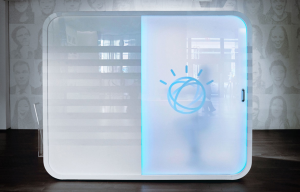
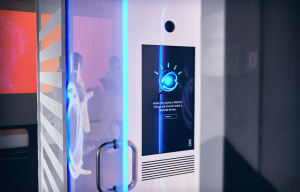
![[OLD FALL 2017] 15-104 • Introduction to Computing for Creative Practice](../../../../wp-content/uploads/2020/08/stop-banner.png)

